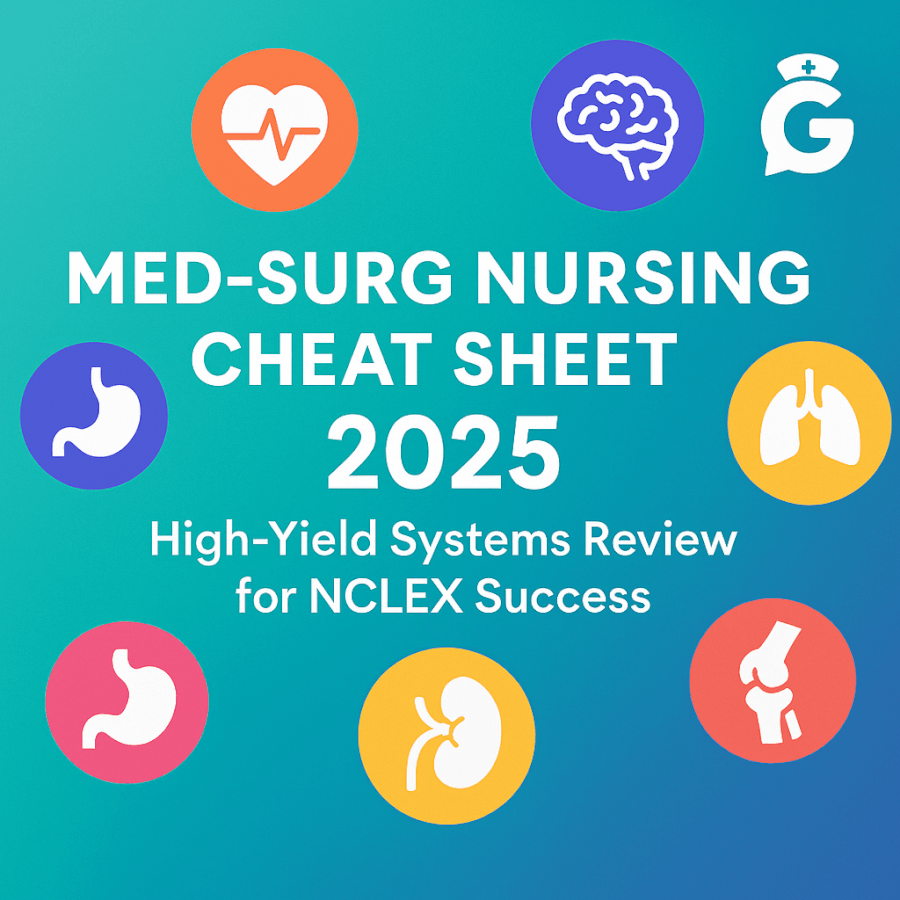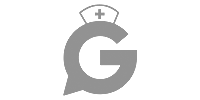I. Introduction: Conquering Med‑Surg for the NCLEX
Medical–surgical (med‑surg) nursing spans every body system, making it one of the most comprehensive sections of the NCLEX. Students often feel overwhelmed by the breadth—cardiac emergencies, respiratory failure, renal insufficiency and more. This cheat sheet distills high‑yield disorders, labs and nursing priorities for each major system so you can focus on what truly matters. Use these summaries alongside GoodNurse’s practice questions and in‑depth articles to build a winning study plan.
🎯 Free med‑surg quiz!
See where your knowledge stands before test day.
II. Cardiovascular System
A. Myocardial Infarction (MI)
| Item | Key Points |
|---|---|
| Classic Signs | Chest pain unrelieved by rest, diaphoresis, nausea, radiating pain to jaw/arm |
| Diagnostics | Elevated troponin I/T, ST‑segment changes; CK‑MB rises in 4–6 hrs |
| Immediate Care | MONA: Morphine, Oxygen, Nitroglycerin, Aspirin |
| Nursing Priorities | Continuous ECG, IV access, prepare for PCI within 90 minutes |
B. Heart Failure (HF)
Mnemonic: FACES
Fatigue • Activity intolerance • Congestion • Edema • Shortness of breath
- Monitor BNP (↑ > 100 pg/mL indicates HF).
- Administer ACE inhibitors or ARBs to reduce afterload, diuretics for fluid overload.
- Teach daily weights, low‑sodium diet and fluid restriction.
Further reading: The Ultimate NCLEX Study Mega Guide
III. Respiratory System
A. Chronic Obstructive Pulmonary Disease (COPD)
- Key Indicators: Barrel chest, prolonged expiration, diminished breath sounds.
- ABG Pattern: ↑ PaCO₂, ↓ PaO₂; compensated respiratory acidosis.
- Interventions: Administer bronchodilators (albuterol, ipratropium), low‑flow oxygen (2 L/min), encourage pursed‑lip breathing.
- Patient Education: Quit smoking, receive annual influenza and pneumococcal vaccines.
B. Pulmonary Embolism (PE)
- Signs: Sudden dyspnea, chest pain, tachycardia, hemoptysis.
- Diagnostics: D‑dimer, CT pulmonary angiography.
- Treatment: IV heparin or LMWH, thrombolytics for massive PE, surgical embolectomy if indicated.
- Nursing Priorities: Elevate HOB, maintain oxygenation, monitor for bleeding with anticoagulants.
IV. Renal & Fluid–Electrolyte Balance
A. Acute Kidney Injury (AKI)
- Phases: Oliguric → Diuretic → Recovery.
- Labs: ↑ BUN/creatinine, ↑ K⁺, metabolic acidosis.
- Interventions: Strict I&O, fluid challenges or diuretics, prepare for dialysis if refractory.
- Mnemonic: “RIFLE” (Risk, Injury, Failure, Loss, End‑stage) for staging severity.
B. Chronic Kidney Disease (CKD)
- Management: Control HTN and diabetes, restrict protein and phosphorus, administer erythropoietin for anemia.
- Dialysis Teaching: Weigh before/after, hold certain meds (e.g., antihypertensives) before hemodialysis.
Questions, Answers, and Explanations: Renal Nursing Review for NCLEX
V. Neurological System
A. Stroke (CVA)
- FAST mnemonic: Facial droop, Arm weakness, Speech difficulty, Time.
- Ischemic vs Hemorrhagic: CT scan differentiates; tPA within 4.5 hrs for ischemic strokes.
- Nursing Priorities: Frequent neuro checks (GCS), maintain airway, prevent aspiration, manage BP within target range.
B. Increased Intracranial Pressure (ICP)
- Early Signs: Headache, vomiting, blurred vision.
- Late Signs: Cushing triad (↑ BP, bradycardia, irregular respirations), pupillary changes.
- Interventions: Elevate HOB 30°, avoid hip flexion, administer mannitol, maintain normothermia.
🥇Voted #1 Nursing Study Tool.
Personalized AI Tutor + Instant Answers to All Your Questions. 100% Money Back Guarantee!
VI. Gastrointestinal & Hepatobiliary
A. Pancreatitis
Mnemonic: “GET SMASHED” for causes (Gallstones, Ethanol, Trauma, Steroids, Mumps, Autoimmune, Scorpion sting, Hypertriglyceridemia/hypercalcemia, ERCP, Drugs).
- Labs: ↑ Amylase, ↑ Lipase.
- Interventions: NPO, NG suction if severe, pain control (opioids), IV fluids, monitor glucose.
B. Liver Cirrhosis
- Complications: Portal HTN → varices, ascites; hepatic encephalopathy.
- Management: Beta‑blockers for varices, lactulose for ammonia, paracentesis for ascites.
Further reading: Vital Organs to know for the NCLEX
VII. Endocrine Highlights
A. Diabetes Mellitus (DM)
- Type 1 vs Type 2: Autoimmune destruction vs insulin resistance.
- DKA vs HHS: DKA—ketosis/acidosis; HHS—severe hyperglycemia without ketones.
- “Sick Day Rules”: Continue insulin, monitor glucose q4h, drink fluids.
B. Thyroid Disorders
- Hypothyroidism (Hashimoto): Lethargy, weight gain, cold intolerance. Treat with levothyroxine.
- Hyperthyroidism (Graves): Weight loss, heat intolerance, exophthalmos. Treat with PTU, methimazole, beta‑blockers.
More details: Endocrine Disorders NCLEX Review
VIII. Prioritization & Delegation in Med‑Surg
- Use ABC + V: Airway, Breathing, Circulation, Vital signs to decide who to see first.
- Scope of Practice: Delegate stable patients’ vitals to UAP; LPNs can give oral meds but not IV pushes.
- Maslow’s Hierarchy: Address physiological needs (oxygen, pain, elimination) before safety or psychosocial needs.
IX. Quick Reference Labs & Values
| Lab | Normal Range | Red Flag |
|---|---|---|
| Sodium | 135–145 mEq/L | < 120 or > 160 |
| Potassium | 3.5–5.0 mEq/L | < 2.5 or > 6.0 |
| Calcium | 8.5–10.5 mg/dL | < 7.0 or > 13.0 |
| Magnesium | 1.5–2.5 mEq/L | < 1.0 or > 5.0 |
| Creatinine | 0.6–1.3 mg/dL | > 4.0 |
| Troponin I | < 0.03 ng/mL | > 0.4 suggests MI |
| BNP | < 100 pg/mL | > 400 indicates HF |
(For expanded tables covering hematology, liver and clotting labs, see the upcoming Med‑Surg Lab Values Guide.)
X. Mnemonics Round‑Up
| Topic | Mnemonic | Meaning |
|---|---|---|
| MI Treatment | MONA | Morphine, Oxygen, Nitro, Aspirin |
| Heart Failure | FACES | Signs of HF |
| Stroke Assessment | FAST | Face, Arm, Speech, Time |
| Pancreatitis Causes | GET SMASHED | Gallstones, Ethanol, Trauma, etc. |
| DKA Management | “HI E” | Hydration, Insulin, Electrolytes |
XI. Final Thoughts & Continued Learning
Med‑surg covers vast territory, but focusing on high‑mortality disorders, hallmark lab values, and nursing interventions prepares you for most NCLEX scenarios. Pair this cheat sheet with GoodNurse’s practice quizzes and detailed topic guides to reinforce learning:
- Pharmacology Prefixes & Suffixes Cheat Sheet: Rapid drug‑class recognition.
- Electrolyte Imbalances Cheat Sheet: Spot and treat critical lab abnormalities.
- Pediatric Growth & Development Milestones: Key developmental stages.
- Best Nursing Mnemonics for NCLEX Success: Memory hacks to streamline your study.
- How AI is Transforming Nursing Education: Learn how you should utilize AI with your studying
Stay organized, prioritize patient safety and practice continually—your med‑surg mastery will translate to both NCLEX success and competent bedside care.






